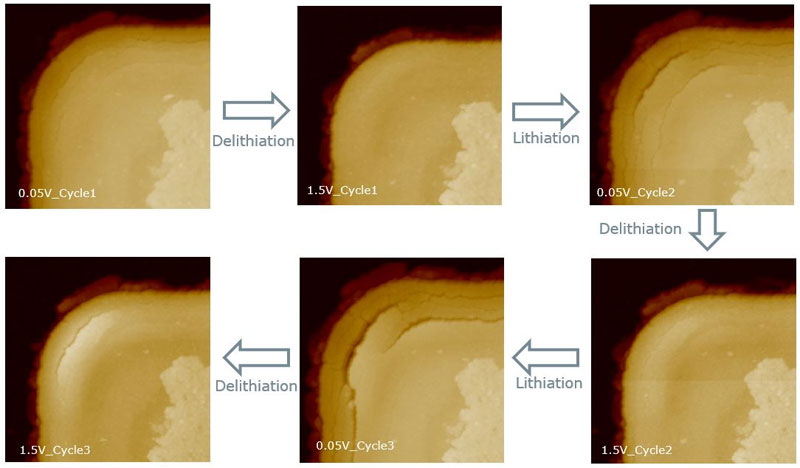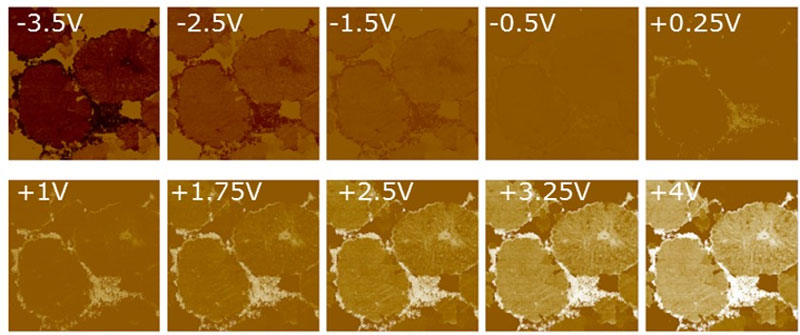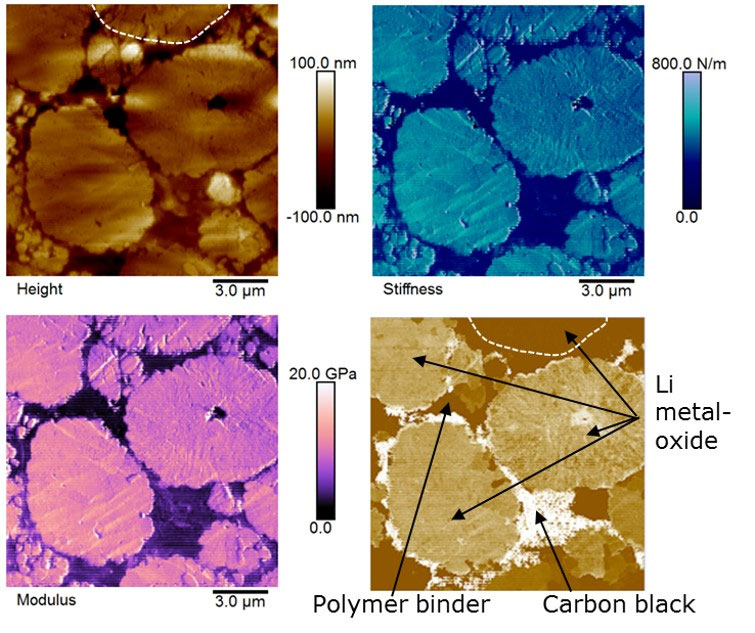Battery Research with AFM
Researchers at CAS Beijing have published a paper about SEI layer formation, which affects battery power density and lifetime. They imaged the anode using AFM (Atomic Force Microscopy), which is a useful tool in battery research for in-situ, in operando characterisation.
Blue Scientific is the official Nordic distributor for Bruker AFM in Norway, Sweden, Denmark, Finland and Iceland. For more information or quotes, please get in touch.
More about battery research
Bruker AFM range
Contact us on +44 (0)1223 422 269 or info@blue-scientific.com
Follow @blue_scientificScientific Paper: SEI Layer Formation
Researchers at CAS Beijing (The University of the Chinese Academy of Sciences) have published a paper in Nature about lithium battery research using electrochemical AFM.
In their investigations into the development of higher capacity anodes, Li-Jun Wan and his group characterised solid electrolyte interface (SEI) film formation on MoS2 (molybdenum disulfide). Using a Bruker Dimension Icon glovebox AFM, they found that the formation of nanoparticle-based films is related to high MoS2 stress and the formation of soft wrinkles. In addition, the capacity degradation mechanism was identified from morphology changes during lithiation.

The full scientific paper from CAS Beijing is available on Nature.com:
Battery Research with AFM
Electrochemical AFM (Atomic Force Microscopy) is useful in various areas of Lithium ion battery research:
- Directly investigate changes on the surface of the electrode
- In situ and in operando imaging
- Measure variations in local electrochemical activity
- … and more
For example, AFM can provide insights into the evolution and degradation of the solid-electrolyte interphase (SEI) layer of high-capacity Li ion anodes. This affects battery power density and lifetime.
At the cathode, correlated electrical and mechanical characterisation can be used to quantify component distribution, characterise conductivity variation, and pinpoint inactive metal oxide grains that limit capacity.
You can also investigate fracture mechanisms and dendrite growth than can lead to battery failure, by imaging the separator membrane with a tensile stage.
AFM can also be used to study energy storage and conversion in other areas, including supercapacitors, fuel cells, and solar cells. It’s particularly useful for measuring local electrochemical activity and surface conductivity in situ and in the presence of the electrolyte.
AFM Modes for Battery Characterisation
- EC-AFM – In situ, in operando characterisation during anode charging cycles.
- PeakForce QNM – Quantitative studies of the SEI layer on high capacity anodes.
- PeakForce SECM – Study local electrochemical activity.
- DataCube modes – Multimodal cathode characterisation.
- Plus glove boxes for environmental control and turnkey solutions.
Imaging the SEI Layer
The lifetime of Lithium ion batteries is affected by the formation and evolution of the passivating SEI layer. Particularly in high capacity anodes, there are large electrode volume changes during battery cycling, which causes significant deformation of the SEI layer.
With AFM you can image the fragile SEI layer directly, in operando – which was previously an extremely challenging procedure. The example below if from research by the Sheldon group at Brown University. The Bruker Dimension Icon was used to image patterned Si anodes in a glovebox, using PeakForce QNM (Quantitative Nanoscale Mechanical Characterisation – more info here).
This enables you to directly observe the formation of cracks in the SEI layer during lithiation. The mechanical degradation is tracked over multiple charging cycles, which do not to repair the initial crack completely – contrary to previous theories.

This leads to investigations into estimating the fracture toughness, which is a key factor in the breakdown of the SEI layer. More details are available in a paper by Brown University, General Motors Global R&D Center and Bruker Nano:
You might also be interested in a paper co-authored by Nobel Laureate John Goodenough about SEI layer studies:
Studying the Cathode
Lithium ion cathodes are a complex, heterogeneous mix. They contain metal oxide particles that store Lithium in a discharged state. These are surrounded by polymeric binder material that accommodates volume changes, mixed with carbon black material for conductivity and power density.
The example below was taken with a Bruker Dimension Icon XR AFM. DataCube SSRM (Scanning Spreading Resistance Microscopy – more info here) was used to map distribution of components and reveals significant variation between particles:

The modulus map from DataCube mode highlights the hard metal oxide particles from the surrounding soft binder, while a conductivity map (acquired simultaneously) reveals the uneven distribution of carbon black.
A particle near the top of the image is not covered by carbon black. A series of conductivity images from the same data cube confirms that the particle is dead, and inactive over the entire operating range of voltages.

More about Battery Research with AFM
Take a look at these application notes and brochures to find out more about AFM modes for battery characterisation:
- Hyperspectral Mapping with AFM DataCube Nanoelectrical Modes
- PeakForce SECM Brochure (Scanning Electrochemical Microscopy and in-situ electrical mapping in liquid)
- PeakForce SECM Application Note
- EC-AFM (Electrochemical AFM)
- Battery Research E-Book from Bruker
These recorded webinars from Bruker are available to watch online:
- In-Situ Studies of SEI Evolution in Li-Ion Batteries: Morphology, Mechanics, and Electrochemistry
- In-Situ, in-Operando PeakForce Tapping Imaging of Li-Ion Batteries in a Glovebox

Bruker Dimension Icon
- Powerful, versatile AFM
- Wide range of modes
- Quantitative nanoscale material property mapping
- Simultaneous nanoscale imaging and nanomechanical analysis
Questions?
Blue Scientific is the official distributor of Bruker AFM in the Nordic region. We’re available to provide quotes and help with all your queries – just get in touch:


